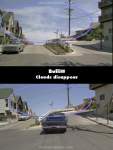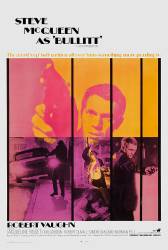Continuity mistake: When Bullitt leans over to read the piping chart, the coat he has draped over his shoulder changes from neatly pressed and folded to wrinkled (and folded differently) between full shots and close-ups. (00:18:30)
Visible crew/equipment: When Bullitt gets out of the cab at the car wash, just before the big chase sequence, the cameraman's reflection is visible on the door window. (01:02:15)
Continuity mistake: During the chase, Bullitt's Mustang skids off the road and kicks up a huge cloud of brown dust that engulfs the car. It should now be coated with dust, but in the next shot of it speeding away, the Mustang is sparkling clean again. (01:14:05)
Continuity mistake: When the security guard is shot at the airport, the door is shattered by the bullet leaving a visible hole. In the closing scene, when the priest is giving the last rites, the glass in the door is intact. (01:50:00)
Suggested correction: The security guard was shot by Ross through the left door. As the priest is giving the last rites, seen through the unbroken glass of right door, the security guard who arrived on scene with Delgetti can be seen removing his hat through the shattered glass of the left door.
Continuity mistake: Steve McQueen passes the same green Volkswagen at least three times while chasing the black Dodge Charger R/T. This is due to the same downhill portion being shown to us from multiple angles to artificially extend the length of the scene.
Other mistake: During the big chase scene, a car hits a camera right after it passes a blue '68 GTO.
Plot hole: The movie is based on one huge plot hole: if it wasn't for the "professional" hitman's sloppy work, Bullitt and his team wouldn't have been needed for much. The hitman enters the hotel room, wounds the policeman, then shoots the target with one shotgun blast to his upper left shoulder area. Any hitman worth his fee knows that this is not likely to be an immediately fatal wound. The hitman had a pump shotgun and should have finished the job right then and there. Surely he had more than two shells. Instead, he sees the target is slumped unconscious, then leaves the hotel room without checking to see that his victim really is dead. Nothing seems to be immediately threatening the hit team, though. The hitman spends the rest of his life trying to finish his job and pays the ultimate price for being lazy.
Continuity mistake: Bullitt runs the Charger off the road into the gas station. The station explodes...Right? Not quite.... The Charger runs off the road, passes BEHIND the gas station; you can see the dust trail rising; and boom, the station explodes on cue.
Continuity mistake: The gray-haired hitman enters the hospital in the dead of night. He ends up being chased through the building by Bullitt for about 10, maybe 20 minutes. But when he safely flees the hospital, we see plenty of bright, morning sunshine.
Visible crew/equipment: As Eddy stands up to go out of Enrico's restaurant with Bullitt, look at the only window that is in the shot. A short male with black hair gets past the crowd-control policeman (in a white helmet) on the sidewalk. The cop reaches out to stop him, but it is too late. The walkie-talkie in the cop's hand has a long antenna. It's quick, subtle and quite humourous.
Continuity mistake: There are three different views of the strangled Mrs. Rennick. 1. Cathy looks down on the body on the floor, after entering the room and leaving the door wide open - notice between the victim's face and left hand that there is nothing on the carpet. A policeman moves his shoes enough to be seen close by her hand, too. 2. A flat black object appears beside the victim's face. The black shoes are now missing. 3. The last view shows a close-up of the object and a clear view towards the door. A policeman and Cathy should both be seen in this view, but they are missing and the door is now closed. (Don't confuse this dark object with her fat, round hair curlers. They are noticeably different lengths and shapes.)
Deliberate mistake: When Bullitt enters the hotel room to do a Recki, we see photos of the injured man on the wall. From this we can conclude one of two actions. 1: The ambulance crew took so long to arrive, the police had plenty of time to take a variety of photos from many angles. 2: The police did not let the medics in until they had taken their photos of a man who was in need of immediate medical attention. Wouldn't the injured man rather have his wounds seen to first than his photo taken?
Continuity mistake: During the chase scene, mainly in the city, the shadows are inconsistent. For example, at the beginning of the chase, Bullitt makes a 180 turn and climbs a short hill, losing the Charger. When the Charger is climbing the hill, the street is in bright mid-day sunlight. After a cut to show the driver's face, the next view of the street shows the houses and street in very different lighting. This is not the only example that shows different shadows, either.

Continuity mistake: During the chase, when Bill Hickman drives the Charger into the residential area, as he loses Bullitt he comes to a distinctive intersection: he first looks right, then left. As he looks left, the first view of the sky shows it is half full of light clouds. A moment later, when the car drives on, the sky is completely clear of clouds. There are other shots showing even heavy clouds/blue sky, too.
Continuity mistake: Changing speed: in two shots of the Mustang during the last of the chase scene, the car's speed changes. As the camera pans with Bullitt's car, passing the gas station on the highway, we see the first explosions, and his car seems to be going about 30-35 MPH. Then, as the car skids across the median into the ditch, the Mustang looks as if it was initially going at least 50% faster.
Factual error: When the hitman shoots the Mustang's windshield, the damage is not consistent with a shotgun blast at close range. The windscreen is actually hit in two separated areas. Winchester would be very unhappy if their guns really shot like this.
Suggested correction: It's fairly realistic for a shotgun blast to be scattered like the one to the Mustang's windshield. Shotguns throw a loose pattern that is often random in their impact.
Visible crew/equipment: During the chase scene, it is too obvious when the hitman in the Charger is replaced by a dummy. Most of the time, such as when the hitmen lose Bullitt, just before the chase begins, we see the hitman with his right shoulder leaning on the passenger door. When we can see into the Charger, either the actor is leaning against the door or we see the dummy sitting about a third of the way away from the door, too much towards the centre of the car. The dummy doesn't flop well with the motion of the car, either.
Continuity mistake: Bullitt parks the Mustang, and when he goes to interrogate the cabbie, there is dirt on the body of the car, behind the left front wheel. The Mustang is clean in all other views of the car, after this parking lot scene.
Continuity mistake: It's well known that two different '68 Fastback Mustangs were used to film Bullitt. The two cars can be seen by watching for the driver-side mirror. It looks as if the re-enforced stunt car had the mirror. The other car can be seen in the night scene, when Bullitt rushes to his shot partner, at the hotel. That car has no mirror on the door.
Continuity mistake: During the famous chase scene, most shots of the Charger show its rearview mirror where it normally should be, attached on its arm, above the windscreen. At the point when the Charger crests the "stepped" hill, though, the hitman briefly flashes his left hand in front of the camera lens, but there is no mirror. The mirror was obviously removed to improve the view.





